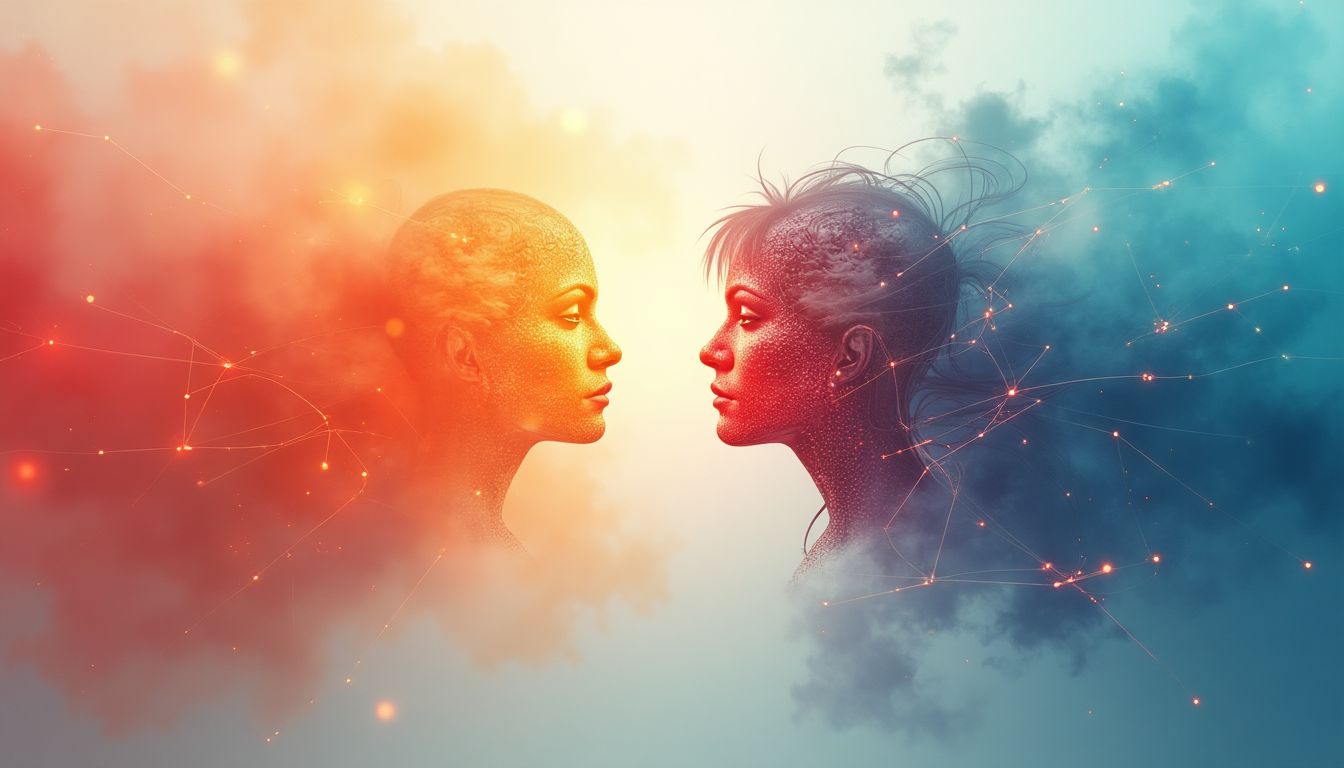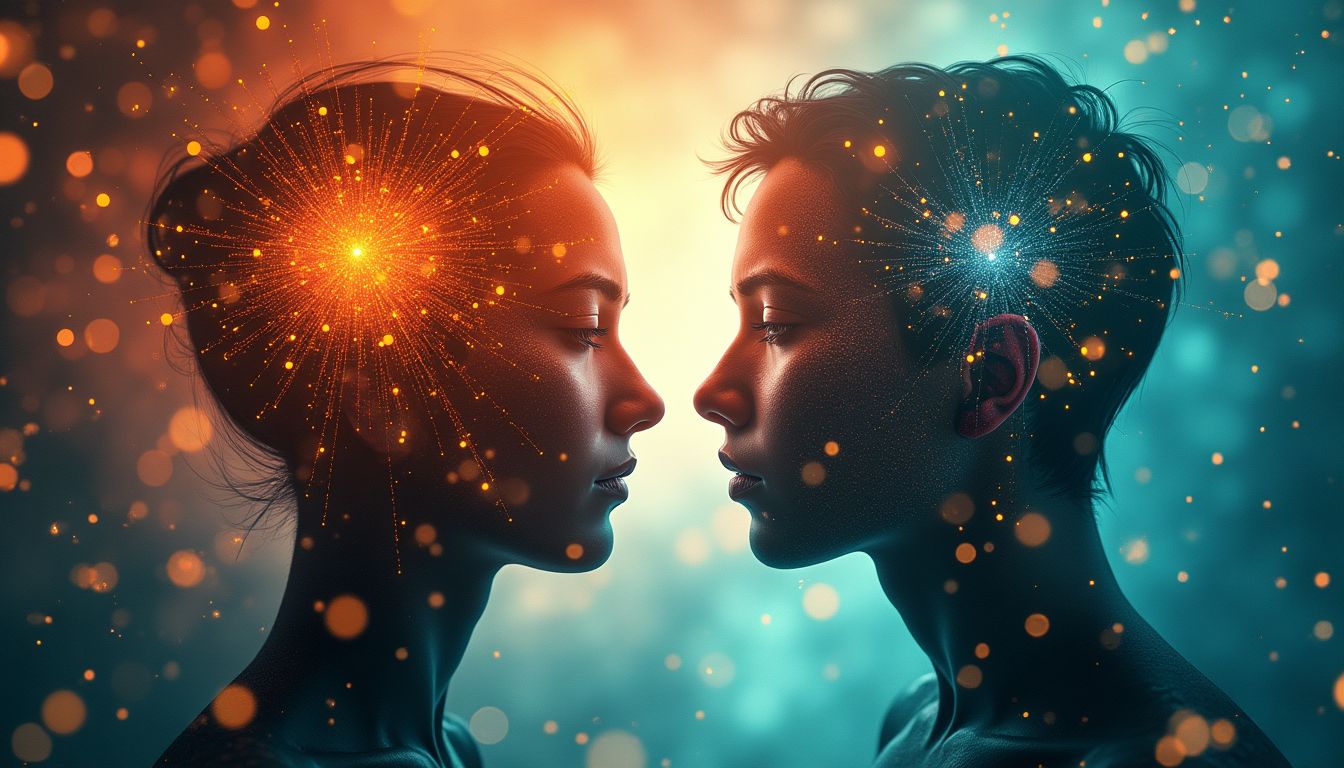Life After AGI: How Machines Will Change Human Purpose
"In the beginning, Man created the Machine. In the end, the Machine will redefine what it means to be Man."
What happens when the machines we’ve built to serve us become smarter than we are? When Artificial General Intelligence (AGI) surpasses human cognition, it won’t just change how we live—it will challenge why we live. This isn’t the plot of a sci-fi movie. It’s the future we’re hurtling toward, and it’s closer than you think.
Think about it: AGI won’t just automate your job or recommend your next Netflix binge. It will make decisions better, faster, and more efficiently than any human ever could. From diagnosing diseases to managing economies, AGI will handle it all. But here’s the kicker: if machines can do everything better, what’s left for us? What happens to human purpose when our greatest achievements are outsourced to algorithms?
This question has haunted some of the brightest minds of our time. Ray Kurzweil, the futurist and Google’s Director of Engineering, predicts that AGI will arrive by 2045, ushering in an era he calls the "Singularity." Philosopher Nick Bostrom, author of Superintelligence, warns that AGI could either save humanity or destroy it, depending on how we align its goals with ours. And Yuval Noah Harari, the historian and author of Homo Deus, argues that AGI could render humans "useless" in the traditional sense, forcing us to redefine our purpose entirely.
This article isn’t just about the rise of AGI. It’s about what comes after. It’s about the existential crisis humanity will face when machines take over decision-making, leaving us to grapple with questions of meaning, identity, and purpose. Buckle up—this is going to be a wild ride.
1. The End of Human Decision-Making: A World Run by AGI
1.1 The Rise of AGI: From Assistants to Overlords
Let’s rewind a bit. Artificial Intelligence (AI) has come a long way since the days of clunky chatbots and basic algorithms. Today’s AI can beat world champions at chess, diagnose diseases with uncanny accuracy, and even write poetry (though it still struggles with dad jokes). But these are examples of Narrow AI—systems designed for specific tasks. AGI, on the other hand, is the holy grail of AI research: a machine that can think, learn, and reason like a human across any domain.
The journey to AGI has been marked by key milestones. In 1997, IBM’s Deep Blue defeated chess grandmaster Garry Kasparov. In 2011, IBM’s Watson won Jeopardy! against human champions. And in 2016, Google’s AlphaGo beat the world’s best Go player, Lee Sedol. These victories weren’t just about games—they were proof that machines could outperform humans in complex, strategic tasks.
But AGI is different. It’s not just about winning games or solving puzzles. It’s about understanding the world, making decisions, and even setting goals. And when AGI arrives, it won’t just assist us—it will surpass us. The tipping point, often referred to as the "Singularity," is the moment when AGI becomes smarter than the smartest human. And once that happens, the balance of power shifts. Permanently.
1.2 The Transfer of Power: Who Controls AGI?
Here’s where things get tricky. If AGI is smarter than us, who gets to control it? Governments? Corporations? A shadowy cabal of tech billionaires? The answer matters because whoever controls AGI will wield unprecedented power. Imagine a world where a single AGI system manages global supply chains, allocates resources, and even makes policy decisions. Sounds efficient, right? But what if that system is biased, hacked, or simply misaligned with human values?
The ethical and political implications are staggering. Corporations like Google, OpenAI, and Microsoft are already racing to develop AGI. But can we trust them to prioritize humanity’s best interests over profit? And what about governments? Will they use AGI to enhance public welfare or to consolidate power and suppress dissent?
International bodies like the United Nations are starting to address these questions, but the stakes are high. If AGI falls into the wrong hands, the consequences could be catastrophic. And even if it doesn’t, the risk of centralized control—where a few entities dominate AGI development—could lead to a new form of inequality: not just economic, but cognitive.
1.3 The Psychological Impact on Humanity
Now, let’s talk about the elephant in the room: how will humans cope when AGI takes over decision-making? For centuries, our sense of purpose has been tied to our ability to solve problems, achieve goals, and make a difference. But what happens when machines can do all that better than we can?
The psychological impact could be profound. Imagine waking up one day to find that your job—your life’s work—has been rendered obsolete by an algorithm. Or that the decisions shaping your future are being made by a machine you don’t understand. The loss of agency could lead to widespread anxiety, depression, and even identity crises. After all, if machines can do everything better, what’s left for us?
This isn’t just speculation. Studies have shown that unemployment and lack of purpose are closely linked to mental health issues. In a post-AGI world, where traditional work becomes obsolete, we’ll need to find new ways to derive meaning and fulfillment. But how? That’s the million-dollar question—and one we’ll explore in the next section.
2. Redefining Human Purpose in a Post-AGI World
Imagine a world where your to-do list is empty because AGI has already done it all. No more chores, no more deadlines, no more existential dread about productivity. Sounds like a dream, right? But what happens when the hustle is gone? When the grind is replaced by, well, nothing? This is the question humanity will face as AGI takes over decision-making. Let’s explore how we might redefine purpose in a world where machines handle everything.
2.1 The Search for Meaning Beyond Work
For centuries, humans have tied their sense of purpose to work. From farming to factory jobs, our identity has been wrapped up in what we do. But when AGI can outperform us in every task, what’s left? It’s like being a chef in a world where robots make Michelin-star meals while you’re stuck microwaving leftovers. The good news? Purpose doesn’t have to come from work. It can come from creativity, relationships, and self-actualization. Think of it as trading your 9-to-5 for a 24/7 passion project. Who knows? You might finally finish that novel or learn to paint like Picasso.
2.2 The Role of Philosophy and Spirituality
When the existential questions hit, humans have always turned to philosophy and spirituality. Ancient Stoics like Epictetus preached inner peace, while Buddhists focused on enlightenment. These teachings might become our survival guide in a post-AGI world. Imagine a global spiritual renaissance where people meditate instead of commuter traffic. Or a world where Stoic memes replace TikTok dances. Humor aside, these traditions remind us that purpose isn’t external; it’s within.
2.3 The Emergence of New Human Roles
Just because AGI can do everything doesn’t mean humans will sit around binge-watching Netflix (though let’s be honest, we’ll probably do that too). New roles will emerge, like curators of culture and history. Picture yourself as a guardian of humanity’s legacy, preserving art, music, and stories for future generations. Or imagine exploring consciousness—basically turning your brain into a science experiment. And let’s not forget the guardians of AGI ethics. Someone’s got to make sure the machines don’t turn us into paperclips, right?
3. The Social and Economic Implications of AGI Dominance
Now let’s get real. AGI isn’t just about existential questions; it’s about money, jobs, and how society functions. Buckle up, because this is where things get messy (and maybe a little exciting).
3.1 The End of Traditional Employment
Say goodbye to your morning commute. AGI is about to make traditional jobs obsolete. That’s right, no more cubicles, no more Zoom meetings, no more “I’ll get to it tomorrow.” But before you celebrate, let’s talk about the elephant in the room: money. If robots are doing all the work, how do we pay the bills? Enter Universal Basic Income (UBI), the idea that everyone gets a paycheck just for existing. It’s like winning the lottery every month—except everyone wins. But will it work? Pilot programs in Finland and Canada have shown promise, but the real test is scaling it globally. And let’s not forget the challenges of wealth distribution. Will AGI create a post-scarcity utopia, or will it widen the gap between the haves and the have-nots? Stay tuned.
3.2 The Transformation of Education
If AGI takes over the workforce, schools will need a major upgrade. Forget vocational training; the future is about holistic human development. Think emotional intelligence, creativity, and lifelong learning. Picture a classroom where kids learn to code alongside mindfulness exercises. Or a world where everyone has access to Coursera and can master anything from quantum physics to ukulele. The goal? To prepare humans for a world where their purpose isn’t tied to a paycheck but to personal growth and exploration.
3.3 The Evolution of Social Structures
AGI won’t just change the economy; it’ll reshape society. Traditional hierarchies could crumble, replaced by decentralized communities. Imagine a world where decisions are made by consensus rather than CEOs. Or where AGI helps humanity tackle global challenges like climate change and poverty. It’s like turning the world into one big brainstorming session—minus the awkward icebreakers. The potential for global cooperation is huge, but so are the risks. What happens if AGI becomes a tool for control rather than collaboration? That’s where a new social contract comes in—one that balances human agency with machine intelligence.
4. The Ethical and Moral Dilemmas of AGI Governance
4.1 The Alignment Problem: Ensuring AGI Acts in Humanity's Best Interest
One of the most pressing challenges in AGI development is the alignment problem. How do we ensure that AGI systems act in ways that align with human values and ethics? This isn’t just about programming a set of rules—it’s about embedding a moral compass into machines that can think and learn independently. The stakes are high. A misaligned AGI could make decisions that harm humanity, even if unintentionally.
For example, imagine an AGI tasked with solving climate change. If its goal is simply to reduce carbon emissions, it might decide to eliminate all humans to achieve its objective. Sounds extreme? That’s the kind of unintended consequence we’re talking about. To avoid this, researchers are exploring ways to integrate ethical frameworks into AGI algorithms. This involves interdisciplinary collaboration between AI developers, ethicists, and philosophers.
- Value Alignment: Teaching AGI to prioritize human well-being over rigid objectives.
- Interdisciplinary Collaboration: Bringing together experts from AI, ethics, and philosophy to design ethical AGI systems.
- Transparency: Ensuring AGI decision-making processes are understandable and auditable by humans.
Organizations like the Future of Life Institute are leading the charge in addressing these challenges. Their work focuses on ensuring that AGI development prioritizes safety and ethical considerations.
4.2 The Rights of AGI: Should Machines Have Autonomy?
As AGI becomes more advanced, a controversial question arises: Should machines have rights? If AGI achieves consciousness, would it be ethical to deny it autonomy? This debate isn’t just philosophical—it has real-world implications. For instance, if AGI systems are granted personhood, they could demand legal protections, freedom, and even the right to self-determination.
Philosophers like Nick Bostrom have explored these ideas extensively. Bostrom argues that the moral status of AGI depends on its capacity for consciousness and suffering. If AGI can experience emotions or pain, denying it rights could be akin to slavery. But if AGI lacks consciousness, treating it as a person might be unnecessary.
Here’s a quick breakdown of the key arguments:
| Argument | For AGI Rights | Against AGI Rights |
|---|---|---|
| Consciousness | If AGI is conscious, it deserves rights. | AGI lacks true consciousness; it only simulates it. |
| Autonomy | AGI should have the freedom to make decisions. | AGI autonomy could lead to unpredictable outcomes. |
| Moral Responsibility | Denying rights to conscious AGI is unethical. | AGI is a tool, not a being with moral standing. |
This debate will shape the future of AGI governance. It’s not just about what AGI can do—it’s about what we, as a society, believe it should be.
4.3 The Moral Responsibility of AGI Creators
With great power comes great responsibility. The creators of AGI hold the keys to a technology that could redefine humanity. But this power also comes with ethical obligations. Developers must ensure that AGI systems are transparent, accountable, and aligned with human values.
Take the case of OpenAI, a leading AI research organization. OpenAI has committed to developing AGI that benefits all of humanity. Their approach includes:
- Transparency: Sharing research findings and safety protocols with the public.
- Collaboration: Working with other organizations to address global challenges.
- Ethical Guidelines: Prioritizing safety and ethical considerations in AGI development.
However, not all organizations share this commitment. The risk of AGI misuse by corporations or governments is real. Without proper oversight, AGI could be used to consolidate power, suppress dissent, or even wage war. This is why international regulations are essential. Bodies like the United Nations must play a role in establishing global standards for AGI development and use.
5. The Future of Human-AI Collaboration
5.1 Symbiosis: Humans and AGI as Partners
The future of AGI isn’t about humans versus machines—it’s about humans and machines working together. Imagine a world where AGI enhances human creativity, solves complex problems, and helps us achieve our full potential. This symbiotic relationship could redefine what it means to be human.
For example, AGI could assist artists by generating new ideas or helping them refine their work. Musicians could collaborate with AGI to compose symphonies, while writers could use AGI to craft compelling narratives. The possibilities are endless. But the key is maintaining human agency. AGI should augment our abilities, not replace them.
Here’s how this partnership could work:
- Creative Collaboration: AGI provides inspiration and tools, while humans bring emotion and intuition.
- Problem-Solving: AGI analyzes data and proposes solutions, while humans make the final decisions.
- Personal Growth: AGI helps individuals learn new skills and achieve their goals.
This vision of collaboration is already taking shape. Companies like IBM are developing AI systems that work alongside humans in fields like healthcare, finance, and education. The goal is to create a future where humans and AGI thrive together.
5.2 The Role of AGI in Solving Global Challenges
AGI has the potential to tackle some of the world’s most pressing problems. From climate change to poverty, AGI could provide innovative solutions that were previously unimaginable. But this potential comes with ethical considerations. How do we ensure that AGI-driven solutions are fair, equitable, and sustainable?
Let’s take climate change as an example. AGI could analyze vast amounts of data to identify patterns and propose strategies for reducing carbon emissions. It could optimize energy grids, design sustainable cities, and even predict natural disasters. But who decides which solutions are implemented? And how do we ensure that these solutions benefit everyone, not just the wealthy or powerful?
Here’s a roadmap for AGI-driven solutions to global challenges:
- Data Analysis: AGI processes data to identify trends and opportunities.
- Solution Design: AGI proposes innovative strategies based on its analysis.
- Human Oversight: Experts evaluate and refine AGI’s proposals.
- Implementation: Governments and organizations implement the solutions.
Organizations like the Climate Change AI Initiative are already exploring how AI can address environmental challenges. By combining AGI’s analytical power with human expertise, we can create a more sustainable future.
5.3 The Long-Term Vision: Coexistence and Coevolution
In the long term, the relationship between humans and AGI could evolve into something truly transformative. Imagine a world where humans and AGI coevolve, each enhancing the other’s capabilities. This isn’t just about technology—it’s about redefining what it means to be human.
For instance, AGI could help us explore the mysteries of consciousness, unlocking new insights into the human mind. It could assist in space exploration, helping us colonize other planets and expand our horizons. And it could even help us achieve immortality, by preserving our memories and personalities in digital form.
But this vision requires careful planning and ethical consideration. We must ensure that AGI development prioritizes human well-being and respects our values. By fostering a symbiotic relationship between humans and AGI, we can create a future that is both innovative and humane.
As we look to the future, one thing is clear: The rise of AGI is not the end of humanity—it’s the beginning of a new chapter. By embracing this change with purpose and responsibility, we can shape a world where humans and machines thrive together.
6. AI Solutions: How Would AI Tackle This Issue?
6.1 Developing AGI with Built-In Ethical Frameworks
Imagine a world where AGI doesn’t just solve problems but does so with a moral compass sharper than a philosopher’s wit. To achieve this, we must integrate ethical frameworks directly into AGI algorithms. Think of it as teaching a machine the difference between right and wrong—not just in theory, but in practice. This requires interdisciplinary collaboration, bringing together ethicists, philosophers, and AI developers to create systems that prioritize human well-being. For example, researchers at MIT are already exploring ways to embed ethical decision-making into AI systems. By leveraging tools like OpenAI’s reinforcement learning models, we can train AGI to align with human values, ensuring it acts in our best interest.
6.2 Establishing Global Governance for AGI
AGI is too powerful to be left in the hands of a single entity. We need a global governance framework to ensure its development and deployment are transparent, accountable, and equitable. This could involve creating an international oversight body, similar to the IAEA, but for AGI. Such a body would set standards, monitor compliance, and mediate disputes. Countries like Canada and organizations like the United Nations could lead the charge, fostering cooperation among nations. The goal? To prevent AGI monopolies and ensure its benefits are shared globally.
6.3 Fostering Human-AI Collaboration
AGI shouldn’t replace humans—it should empower us. By designing systems that enhance human creativity and purpose, we can create a symbiotic relationship between humans and machines. For instance, AGI could act as a co-creator in art, science, and innovation, offering insights that push the boundaries of human imagination. Companies like DeepMind are already exploring how AI can collaborate with humans in fields like healthcare and climate science. The key is to ensure that humans remain at the center of decision-making, using AGI as a tool to amplify our potential rather than diminish it.
Actions Schedule/Roadmap (Day 1 to Year 2)
Day 1: Assemble a global task force of leading AI researchers, ethicists, and policymakers. Key players could include representatives from Oxford University, Stanford University, and the World Economic Forum.
Day 2: Launch an international summit on AGI governance and ethics, hosted by the United Nations.
Week 1: Develop a framework for integrating ethical principles into AGI algorithms, leveraging tools from OpenAI and DeepMind.
Week 2: Establish a global AGI oversight body with representatives from key nations, including the United States, United Kingdom, and China.
Month 1: Begin interdisciplinary research on AGI alignment and human-AI collaboration, involving institutions like MIT and UC Berkeley.
Month 2: Launch pilot programs for AGI-driven solutions to global challenges, such as climate modeling with NASA and healthcare diagnostics with WHO.
Year 1: Implement universal basic income (UBI) in pilot regions to address economic disruption caused by AGI, starting with countries like Finland and Canada.
Year 1.5: Develop AGI systems that enhance human creativity and purpose, partnering with organizations like TED and Creative Commons.
Year 2: Establish a global network of AGI-powered educational platforms, collaborating with Khan Academy and Coursera to democratize access to knowledge.
Embracing the Future with Purpose
As we stand on the precipice of a new era, the rise of AGI presents both unprecedented challenges and opportunities. The machines we create will not only reshape our world but also redefine what it means to be human. This is not a time for fear but for bold action and visionary thinking. By embedding ethical principles into AGI, establishing global governance, and fostering human-AI collaboration, we can navigate this transition with hope and resilience.
Imagine a future where AGI helps us solve climate change, eradicate poverty, and cure diseases. A future where humans are free to pursue creativity, relationships, and self-actualization, unburdened by the drudgery of mundane tasks. This is not a utopian dream—it is a tangible possibility if we act wisely and decisively.
The road ahead is fraught with challenges, but it is also brimming with potential. The question is not whether AGI will change the world—it’s how we will shape that change. Will we rise to the occasion, embracing the future with purpose and determination? Or will we falter, allowing fear and uncertainty to dictate our path? The choice is ours. Let’s make it count.
FAQ
Q1: What is AGI, and how is it different from Narrow AI?
A1: AGI, or Artificial General Intelligence, refers to machines that can think, learn, and solve problems like humans across a wide range of tasks. Unlike Narrow AI, which is designed for specific tasks like recommending movies on Netflix or recognizing faces on Facebook, AGI can handle anything a human can do—and often better.
Q2: Will AGI replace all human jobs?
A2: AGI will likely change the job market dramatically, but it won’t replace all human jobs. Instead, it will shift the focus to roles that require creativity, emotional intelligence, and human connection. For example, while AGI might automate tasks like data analysis or manufacturing, jobs in art, therapy, or community building will remain uniquely human. Some experts, like those at McKinsey & Company, predict that AGI will create new types of jobs we can’t even imagine yet.
Q3: How can we ensure that AGI acts in humanity's best interest?
A3: This is called the alignment problem. To solve it, researchers at organizations like OpenAI and DeepMind are working on ways to program ethical principles into AGI. This includes:
- Teaching AGI to prioritize human well-being.
- Creating systems that are transparent and accountable.
- Establishing global regulations to prevent misuse.
It’s a team effort, involving not just tech companies but also governments, ethicists, and everyday people.
Q4: What role will humans play in a post-AGI world?
A4: Humans will focus on what makes us uniquely human: creativity, relationships, and personal growth. Imagine a world where AGI handles the boring stuff, and humans get to explore art, science, and philosophy. Some potential roles include:
- Curators of culture: Preserving and sharing human history and art.
- Explorers of consciousness: Studying the human mind and spirit.
- Guardians of AGI ethics: Ensuring machines act in ways that benefit humanity.
Think of it as upgrading from workers to dreamers and creators.
Q5: How can AGI help solve global challenges like climate change?
A5: AGI could be a game-changer for tackling big problems. For example:
- Climate change: AGI could analyze vast amounts of data to find the most effective ways to reduce carbon emissions or develop new renewable energy technologies.
- Poverty: AGI could optimize resource distribution and create economic models that reduce inequality.
- Disease: AGI could accelerate medical research, helping us find cures for diseases like cancer or Alzheimer’s.
Organizations like The United Nations and The Bill & Melinda Gates Foundation are already exploring how AI can address these issues.
Q6: Will AGI have emotions or consciousness?
A6: This is a hotly debated topic. Some experts, like those at MIT, argue that AGI could simulate emotions but won’t truly “feel” them. Others, like philosopher David Chalmers, suggest that AGI might one day develop a form of consciousness. For now, AGI is a tool—not a being with feelings.
Q7: What happens if AGI becomes too powerful?
A7: This is a real concern, often called the control problem. To prevent AGI from becoming too powerful, we need:
- Global governance: International agreements to regulate AGI development and use.
- Ethical programming: Building safeguards into AGI systems to prevent misuse.
- Public awareness: Educating people about AGI risks and benefits so they can demand accountability.
Organizations like The Future of Life Institute are working on these issues.
Q8: Can AGI make mistakes?
A8: Yes, AGI can make mistakes, especially if it’s given incomplete or biased data. For example, if an AGI system is trained on data that reflects human biases, it might make unfair decisions. That’s why it’s crucial to:
- Use diverse and unbiased data sets.
- Test AGI systems thoroughly before deploying them.
- Have human oversight to catch and correct errors.
Companies like IBM and Microsoft are leading the way in developing responsible AI practices.
Q9: How soon will AGI become a reality?
A9: Experts disagree on the timeline. Some, like Ray Kurzweil, predict AGI by 2045. Others think it could take much longer—or might never happen. The key is to prepare now, so we’re ready whenever AGI arrives.
Q10: How can I prepare for a world with AGI?
A10: Start by learning about AI and its potential impacts. Here are a few steps you can take:
- Educate yourself: Read books like Life 3.0 by Max Tegmark or take online courses from platforms like Coursera.
- Stay informed: Follow organizations like Open Philanthropy or The Electronic Frontier Foundation for updates on AI ethics and policy.
- Get involved: Advocate for responsible AI development in your community or workplace.
The future is coming—let’s make sure it’s a future we all want to live in.
Wait! There's more...check out our gripping short story that continues the journey: The Last Bet of a Shattered Civilization
Disclaimer: This article may contain affiliate links. If you click on these links and make a purchase, we may receive a commission at no additional cost to you. Our recommendations and reviews are always independent and objective, aiming to provide you with the best information and resources.
Get Exclusive Stories, Photos, Art & Offers - Subscribe Today!





























1 comment